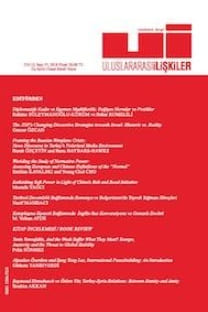Gücün Farklı Düzeylerde Teorik bir Değerlendirmesi:Irak Konusunda ABD-Türkiye İlişkileri
Bu makalede bir lider (patron/hegemon) ülke tarafından lider-olmayan (müşteri) bir ülkeyi kendi siyaseti doğrultusunda işbirliğine çekme yönünde gücün farklı formlarda (düzeylerde) nasıl kullanıldığı araştırılmaktadır. Literatürde işbirliği üzerine yazılmış eserler çoğunluğu siyasetin doğrudan gözlemlenebildiği pazarlık gücü üzerinde yoğunlaşmaktadır. Bu makale lider-olmayan bir ülke olan Türkiye ile lider ülke olan Amerika arasındaki Körfez Krizi (1990) ve Irak Savaşı (2003) dönemlerindeki ilişkilerinin tam olarak anlaşılmasında pazarlık gücü modelinin yeterli olmadığını göstermektedir. Bu makalede Karause’un üç düzeyli güç modelinin Türkiye ve Amerika Birleşik Devletleri arasındaki güç ilişkisini en kapsamlı şekilde anlamak ve açıklamak için çok daha iyi bir model olduğu iddia edilmektedir.
Anahtar Kelimeler:
Türkiye, Irak, Pazarlık/Müzakere Gücü, Yapısal Güç, Hegemonyacı Güç.
A Theoretical Evaluation of Different Faces of Power:US-Turkey Relations Towards Iraq
This paper focuses on the use of different forms of power by a (leader/patron/hegemonic) state to get the other (non-leader/client) states to cooperate with its policies. Most of the literature on cooperation operates on the level of bargaining power where the policy changes are directly visible. This article aims to show how the bargaining power model is not adequate in capturing the complete picture of the relationship between Turkey (a non-leader/client state) and the United States (leader/patron state) in their cooperation with regard to Iraq during the Gulf Crisis (1990) and the War against Iraq (2003). Hence, I attempt to show that the three levels of power as discussed by Krause is a better and more comprehensive framework for understanding and explaining the power relationship between Turkey and the US
Keywords:
Turkey, Iraq, Bargaining Power, Structural Power, Hegemonic Power,
___
- .....
- ISSN: 1304-7310
- Başlangıç: 2004
- Yayıncı: Uluslararası İlişkiler Konseyi Derneği İktisadi İşletmesi
Sayıdaki Diğer Makaleler
Richard Balme and Didier Chabanet, European Governance and Democracy: Power and Protest in the EU
Onur Yıldırım, Diplomasi ve Göç Türk Yunan Mübadelesinin Öteki Yüzü
Eleştirel Gerçekçilik: Uluslararası İlişkiler Kuramında Post-Pozitivizm Sonrası Aşama
Terörün Sosyolojisi: Toplumsal Kökenleri Anlama İmkanı
Gücün Farklı Düzeylerde Teorik bir Değerlendirmesi:Irak Konusunda ABD-Türkiye İlişkileri
Nükleer Enerji Sahibi Olma Kararını Etkileyen Faktörler ve Türkiye için Tahminler
Bülent KÖKSAL, Abdülkadir CİVAN
Türkiye’nin Nükleer Enerji Siyaseti: İç ve Dış Etkenler
Almanya’daki Feminist Tartışmalarda Başörtüsü Meselesinin Analizi
